
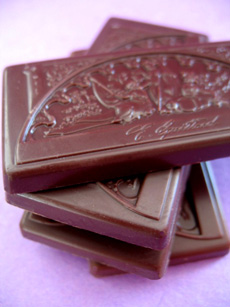
It’s easy to jump into the world of single origin chocolate with Guittard’s Single Origin Chocolate Tasting Kit. Photo by Melody Lan.
|
KAREN HOCHMAN is Editorial Director of THE NIBBLE and wrote this article. The tasting notes are from PETER ROT,THE NIBBLE’s chocolate reporter.
|
October 2006
|
 |
E. Guittard Single Origin Chocolate Tasting Kit
An Evening Of Education & Entertainment
CAPSULE REPORT: With 65% semisweet cacaos from four different regions of the world, you can taste the concept of “single origin cacao”—how chocolate grown in different areas tastes distinctly different, just as, e.g. Pinot Noir grown in Burgundy, Oregon, California and Long Island will be fundamentally different but with some varietal commonality. Four tasting squares from four different regions allow four friends a social tasting experience...or one person four return visits to contemplate the regional distinctions. Our suggestion: do both! The next time you have guests for coffee, treat them to a chocolate tasting as well. Use our notes here, and you’ll have an evening’s entertainment combined with some tasty education.
Most of the chocolate one consumes is a blend of beans from many locations. As with wines, blending enables the producer to compensate for limitations in one growing area with strengths in another, and to create a uniform “house style” and flavor year after year.
As with grapes and coffee beans, terroir (the soil components) and microclimate have a huge impact on the final flavor of the fruit. The same cutting planted in different regions will produce a different-tasting grape or bean. The concept of single origin beans—chocolate bars (and also, bonbons and truffles) where the couverture is made 100% from beans that come from the same region, was championed by the patissier and chocolatier Jean Jacques Bernachon of Lyon, France in the early 1980s. He noted the superiority of the single origin cacao from Chuao over cacao blends, and used it in his chocolates.
Valrhona, the French chocolate powerhouse, was the first to translate the concept to the larger market, pioneering what it called Grand Cru chocolate and precipitating a movement that has grown into today’s chocolate connoisseurship. Valrhona launched the first single origin chocolate bar in 1986. Now there are many, and devotees study fine chocolate bars as wine lovers analyze fine wine, with an understanding of the terroir and microclimate of the bean and their impact on the flavors and aromas in the chocolate produced in those regions—even on specific plantations! As the best beans are reserved for the best bars, these singe origin chocolate bars represent the best chocolate in the world. In terms of unique characteristics and layers of complex flavors, they are analogous to the finest wines.
For chocolate-lovers who want to learn more about single origin chocolates, one route is to buy different chocolate bars, break off pieces, taste and compare. The other is to use tasting squares, also called palets or napolitains. They are small, individually-wrapped pieces, generally 5g or 10g in weight, an inch square or slightly larger. In fact, we prefer to taste from regular-size bars for two reasons: a larger chunk of chocolate in the mouth engenders a better tasting experience, and occasionally the tasting squares just don’t taste as well-rounded as the producers’ large bars.*
*The small squares seem to lose their flavor more readily and absorb outside odors more easily.
However, nothing beats the charm of a tasting kit: neatly assembled pieces of chocolate that give you the “lesson plan”—the chocolates selected, sized and organized, plus a brochure with information. They provide a nice, neat way to taste with a group of friends. They also make a great gift for chocolate-lovers.
About Tasting Kits
To date, several top chocolate companies have offered chocolate tasting kits to make educating one’s palate easier.
- The first, and most extensive offering, comes from France’s Michel Cluizel. Five different samplers let you learn about cacao from the perspectives of single plantation chocolate (1er Cru), single origin chocolate (Origines du Monde) and different percentages of cacao (Grandes Teneurs en Cacao). The charmingly-named “Once upon a Bean” (“Il Etait une Feve”) takes you from the beginning of chocolate production, with samples of the unroasted cacao beans, cocoa butter, cacao mass (chocolate liquor), cacao nibs and samples of the final product: white chocolate, blended 45%, 72% and 85% cacao chocolate and a single plantation dark chocolate. No chocolate education would be complete without one of these, as well as an 1er Cru, Origines du Monde and Grandes Teneurs en Cacao tasting boxes. All can be shared at a home tasting or kept for one’s personal studies, and are available from ChocolatMichelCluizel-NA.com, 1.212.477.7335.
- Amedei offers a sampler of its I Cru origin chocolates, Pralus’ famous Pyramide des Tropiques is available in a Mini-Pyramide of 5g tasting squares, and Valrhona’s Gran Crus de Chocolat Noir has individual squares of Valrhona’s “Grand Cru” bittersweet chocolates (available at Chocosphere.com). To read more about these great producers, read our House Tour article on the world’s great chocolate producers.
From the home team, San Francisco’s Guittard offers tasting squares of four of their origin chocolates. The E. Guittard Single Origin Tasting Kit enables one to get to know Guittard’s single origin bars, while showcasing how different chocolate can taste, even from close neighbors like Colombia, Ecuador and Venezuela.
The Chocolates
Send for your tasting kit and a small, neat box arrives with 10g (.35 ounce) tasting squares of single origin cacao from prime growing regions of four of the world’s best cacao-producing countries. All are 65% semisweet cacao. (Note that Guittard uses the term “bittersweet.” There are no industry standards, and others, including THE NIBBLE™, have defined semisweet as 50% to 69% cacao and bittersweet chocolate at 70% to 100% cacao. Thus, we will refer to this cacao as semisweet to be consistent with all of our other chocolate articles.)
|
 |
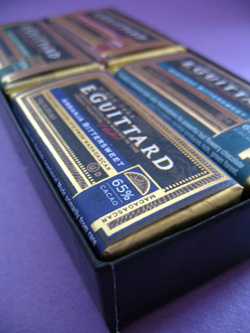
E. Guittard Single Origin Tasting Kit. |
The single origin chocolates are:
- Ambanja from Madagascar (Criollo beans)
- Chucuri from Colombia (Trinitario beans)
- Quevedo from Ecuador (Nacional beans)
- Sur del Lago from Venezuela (Criollo and Trinitario beans)
One might question if this is a “fair comparison” because the beans are not of the same variety. The answer is: these are the varietals that grow best in these regions. So, you are fairly tasting the best Ecuadorian cacao, the best Venezuelan cacao, et al.
While we like this tasting kit and give it as gifts, we would love for these two “corrections” to be made in the next edition:
- The kit provides no real tasting notes, just a one-liner inside a paragraph of each region. We would hope that a tasting kit meant to educate would provide more information on the many flavors of cacao in general, the aromas of chocolate, the differences in chocolate grown in different regions, et al. In the absence of Guittard’s guidance, ours follows—not simple “tasting notes” but chocolate reporter Peter Rot’s reviews of these chocolate bars. We also have listed some of our own reference articles on chocolate at the end of this article, for those who wish to study more.
- There are four different designs on the tasting squares (Guittard’s are rectangles,
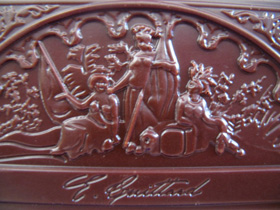 to be precise). When we unwrapped the top layer of the box, which featured one square of each flavor, each had a bas-relief design of native women with a large cacao pod (photo at left). We assumed that every piece was like this, but as we dug deeper into the layers, we discovered the three other designs, variations of the Guittard logo. Now, it would have made sense if each flavor had been given its own design. Then, when the chocolate was unwrapped for a group tasting, the different origins wouldn’t be confused, and everyone could be on the same page (“Now we’re tasting Chucuri, the piece with the large “G” logo in the center.) Instead, like a deck of cards, it seems that each flavor is packed with one of each of the four designs. This means that if four people participate in a tasting, each person’s Chucuri will look completely different from the other. to be precise). When we unwrapped the top layer of the box, which featured one square of each flavor, each had a bas-relief design of native women with a large cacao pod (photo at left). We assumed that every piece was like this, but as we dug deeper into the layers, we discovered the three other designs, variations of the Guittard logo. Now, it would have made sense if each flavor had been given its own design. Then, when the chocolate was unwrapped for a group tasting, the different origins wouldn’t be confused, and everyone could be on the same page (“Now we’re tasting Chucuri, the piece with the large “G” logo in the center.) Instead, like a deck of cards, it seems that each flavor is packed with one of each of the four designs. This means that if four people participate in a tasting, each person’s Chucuri will look completely different from the other.
Tasting Notes
If this is your first Colombian, Ecuadorian, Madagascan or Venezuelan cacao, note these comments for future reference. Each chocolate producer has its own style, just like Cabernet Sauvignons from ten different Napa Valley producers will taste completely different from each other, while having some varietal features in common. At a future tasting, gather single origin bars from four different producers to taste and contrast.
Ambanja
Cacao Content: 65%
Origin: Madagascar (Sambirano Valley)
Bean: Criollo
Wrapper: Purple
|
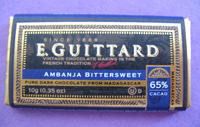 |
Overview: Guittard’s entry is spicier than most Madagascar chocolates and not so prominent on the citrus. One of the better efforts with the origin, and a versatile-chocolate as well: not only for straight eating but for baking and confectionery use.
Appearance: On the light side, approaching a shade that could be mistaken for a dark milk chocolate.
Aroma: Light and complex with blueberries and prunes laid atop an abundant spice cabinet, and a pinch of cedar.
Flavors: The flavor begins with a surge of blueberry, and then the spice cabinet opens to reveal cloves, nutmeg and cinnamon, which all merge into allspice. Orange emerges and the sensation is Lebkuchen, or gingerbread studded with citrus. A bold cedar tone can be detected as well. Toward the end, a subtle rise in chocolatiness occurs, along with the introduction of soft vanilla notes and a continuing trace of woodiness to round off the flavor before the chocolate slips into a short finish. The texture is superb, and the chocolate melts with an ultra-smooth consistency. The acidity is surprisingly low, which is good: if stronger, it could dominate the chocolate and detract from the delicate flavor, rather than enhance it.
Comment: Ambanja is soft and soothing, neither peppered with acidity nor weighed down by excessive spice or woodiness. It’s a magnificent display of control and balance. This is a versatile chocolate, an excellent selection for people craving fruity Madagascan chocolate without the strong acidity that characterizes most other bars from this country. Ambanja’s flavors are strong and well-defined. The flavors may seem a tad out of the ordinary for Madagascar chocolate, but it offers an enjoyable delicacy combined with a sense of sophistication and elegance.
Chucuri
Cacao Content: 65%
Origin: Colombia (San Vicente de Chucuri Valley)
Bean: Trinitario
Wrapper: Green |
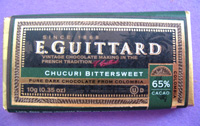 |
Overview: The most “seductive” bar of the group, “beauty and grace” with a feminine delicacy and a floral note. Long, deep chocolate flavors are accented by pleasant hints of spice.
Appearance: Dark brown with a magenta and light burgundy tint.
Aroma: The aroma is quiet and reserved, but with an elegant perfume. It’s mildly crisp and sparkling on the nose, glistening with jasmine and a clear chocolatiness.
Flavor: Elegant chocolate with pound cake flavors is followed by cool melon, and finally, an ending surge of chocolatiness and floral note leading into a strong finish of jasmine. The texture is rather surprising in light of the relaxing flavor: it’s dusty and slightly dry and could use some improvement to complement the gorgeous flavors, but this may be stylistic of Guittard. Regardless, though, as it stands, this is a beautiful chocolate all around, near perfect in its execution, and yet another example of Guittard’s mastery of the semisweet.
Comment: This is a very enchanting chocolate. Chucuri is definitely not as intense as other Colombian cacaos. While it does not completely abandoned the “masculine” Colombian base, Chucuri assumes a decidedly feminine stature. There is a marriage between these two components, with a stronger emphasis on the delicate flavor, which may lend a sweeter nature to the chocolate.
Quevedo
Cacao Content: 65%
Origin: Ecuador, town of Quevedo in the north
Bean: Nacional, a unique Forastero
Wrapper: Teal |
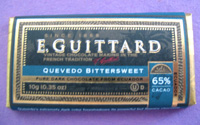 |
Overview: While considered a Forastero bean, Nacional (also called Arriba Nacional) is thought of by some to be a fourth kind of cacao bean, after Criollo, Trinitario and Forastero. It has the delicate flavors and aromas of the Criollo bean, with the yields and other features of a Forastero. It is the primary bean grown in Ecuador, and also in parts of Colombia. Its trademark is floral flavors with hints of green forest, tea and a pound cake finish.
Appearance: The darkest of this group of chocolates, Quevedo looks like a true bittersweet—the others are more reddish-brown, and can resemble a dark milk chocolate (i.e., a high percentage cacao milk chocolate).
Aroma: The aroma is unusually strong, with a centerpoint chocolatiness backing up notes of pound cake and subtle berries.
Flavor: Conversely, the flavor is reluctant to emerge: shy blackberries are followed by a suggestion of green grass. There is a fleeting pound cake flavor, or something vanilla-like and perhaps buttery, but very dessert-like. The chocolate flavor continues softly to the end and some nutty notes appear at the finale. The finish is strong, leaving a chocolatiness that lingers on the palate for quite some time. The texture is by far an improvement over Chucuri and Sur del Lago (below), but nowhere near the creaminess of Ambanja. Not even the slightest trace of acidity is present.
Comment: Quevedo is a nice rendition of the Nacional bean. At just 65% cacao, the intensity is excellent, but one could wish that the flavors were less subtle and reticent. They are too difficult to detect without meticulous attention. On the positive side, the chocolatiness is strong and enduring. Hopefully future bars will find a better balance between the two.
Sur Del Lago
Cacao Content: 65%
Origin: Venezuela, Sur Del Lago Region
Bean: Criollo and Trinitario beans
Wrapper: Dark Red |
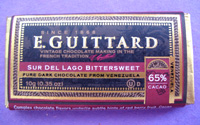 |
Overview: Sur del Lago is one of the oldest and finest chocolate-growing regions of the world. Located in the tropical lowlands south of Lake Maracaibo in northwestern Venezuela, it is typically known for cacao that yields complex flavors and subtle hints of red berry fruit.
Appearance: The color is brick red, typical for Sur del Lago, but perhaps a shade lighter due to the 65% cocoa content.
Aroma: The aroma is faint, masculine and dark, suggestive of a longer roast. It’s initially simple and ganache-like, but raisins later emerge on top with a heavy molasses body, and a very scant suggestion of strawberries or other red fruit.
Flavor: Immediately, a sweet almond and peach note surges but quickly yields to a foundation of raisins, the underpinning tone. The chocolate has a restrained dark tone, one that’s interestingly light and a bit of a divergence for a Sur del Lago cacao, but can be excused by the “lower” percentage. Faint flavors emerge: a hint of cream and quiet red fruits such as cherries and strawberries. A mild acidity peaks in, and then the chocolate finally takes off, bringing more prominent flavors of cream, strawberries and floral notes on top of the body of raisins. There are notes of nuts and a long and intense finish, turning slightly bitter. The texture is quite dusty here, almost chalky with its dryness.
Comments: Sur del Lago is a noble effort at a great cacao, but it isn’t as well wrought as Guittard’s other single origins. The first half of the length struggles before the flavors fully show themselves. It’s like a football team that can’t get it together for the first half of the game, but suddenly finds its focus for the second half. Since the crop varies each year, and the chocolatiers gain more experience working with the beans, we look forward to future versions of this bar.
2-Ounce Chocolate Bar Sampler
|
If the tasting squares seem too small a portion, Guittard offers a chocolate bar sampler box that contains hearty two-ounce bars of everything above, plus two blended bars.†
- Orinoco 38% milk chocolate
- Tsaratana 61% semisweet chocolate
The Tsaratana 61% will let you contrast a blended bar in the 60% range with the single origin bars.
†The bars contain beans from as many as 20 countries.
How To Taste Chocolate
Don’t refrigerate the chocolate prior to tasting. Chocolate should always be tasted at room temperature. Keep chocolate in a cool place with a consistent temperature. Temperature fluctuations can cause chocolate to “bloom.”
These are the steps that professionals use to taste chocolate:
1. Appearance. Unwrap the bar and observe the color of the chocolate. Milk chocolates tend to lighter browns—cinnamon and cafe au lait colors, while dark chocolates are shades of darker browns. The higher the percentage of cacao, the darker the color. Look for hues of orange, brick red, even magenta. You can line up bars of the same percentage cacao from different producers and see differences in color.
- Is the bar glossy or dull (the glossier, the better)? Is it dusty looking or scuffed? It can be old, and this will impact the aroma and flavor.
- Is there a white bloom on the surface of the chocolate? This occurs when the cocoa liquor and cocoa butter separate. Bloom does not impact the flavor—it doesn’t look pretty, but it’s fine to eat.
- Note if the chocolate doesn’t look fresh or natural.
2. Snap. Hold the bar or piece of chocolate firmly in both hands and briskly snap it in half. Fine chocolate should give a satisfying “snap” and yield a smooth break.
- The chocolate should not be crumbly or soft. However, the lower the cacao content, the softer the chocolate is naturally. Milk chocolate and white chocolate will have much less snap than dark chocolate, and 65% cacao chocolate will have much less snap than 85% cacao chocolate.
- Fine chocolate melts at body temperature. If you hold fine chocolate in your hand for a minute or so, e.g. before snapping, it begins to melt due to the extra cocoa butter added for smoothness and mouthfeel.
3. Aroma. Sample the aroma of the chocolate by inhaling it along the surface of the break. The aroma should be smell like chocolate or cocoa, but there are many complex secondary aromas. It requires acclimation to the nuances of detecting and identifying scents, as well as the vocabulary. One generally wouldn’t expect to find scents of cedar, pound cake and strawberry in chocolate. e.g., but they are there.
- The best way to understand aromas is to start with our chart on the aromas of chocolate.
- Compare several different chocolates and concentrate on the differences in aromas.
- Chemical or plastic smells or a lack of aroma altogether indicate inferior chocolate. Chocolate absorbs other odors easily. “Off” odors can indicate bad storage.
4. Mouthfeel. Place a piece of chocolate on your tongue and press it against the roof of your mouth. Fine chocolate should begin to melt slightly, without chewing. Enjoy the initial sensation: fine chocolate will be smooth from the proper production techniques and high level of cocoa butter.
- Is the chocolate smooth or is it grainy or waxy? The latter two are flaws in production, with the exception of some old-style chocolate (a l’ancienne) or Mexican chocolate, which are deliberately grainy.
5. Taste. Then chew and swallow, focusing on the flavors. As with aroma, taste is challenging; even professionals have to focus intently to detect all the nuances, and some chocolates are less forthcoming than others. In addition, some people have great palates and can detect half a dozen flavors off the bat. Other people work for years to develop palate sensitivity.
- Use the flavors and aromas of chocolate chart and don’t hesitate to voice your thoughts, even if you doubt your perceptions. Tastes and aromas can be subjective, but if you think you detect “apricot,” others may realize that they sense it too.
- Different flavors present themselves upon entry, others in mid-palate, and others on the finish. What you sense initially may disappear, to be replaced by other flavors. It can be confusing at first, especially when you’re trying to “nail” all of the different flavors; but over time you will more easily follow the arc of the flavor development. It is one of the things that defines great (complex) chocolate. It’s the same with wine.
Reference Articles
These articles are helpful reference materials. Please note that while they can be used for individual purposes and can be linked to from other websites, all are copyright of THE NIBBLE’s publisher and cannot be reproduced for public distribution or used for commercial purposes without written permission.
Tasting Party
You don’t have to leave town to enjoy a world tour of single origin chocolate—and you don’t have to do much work to throw a chocolate-tasting party. Just buy the kit and provide your guests with:
- Print-outs of the tasting notes, as a frame of reference
- Paper and pens, so the tasters can take their own notes
- Glasses of water and unsalted water crackers (or matzoth), to clear the palate
- A glass or jar of fresh coffee beans—as water and crackers cleanse the palate, unground coffee beans are the perfect “nose cleanser” to keep the sensors fresh to focus on distinguishing aromas
And remember, like the study of wine (or anything else), chocolate isn’t learned in one session. You have to taste, taste, and taste some more. That’s not too burdensome a lesson plan!
GUITTARD CHOCOLATE COMPANY
E. Guittard Single Origin Chocolate Tasting Kit
Certified Kosher by the Orthodox Union
- Single Origin Chocolate
Tasting Kit
16 .35-Ounce Bars
(4 Of Each Flavor Plus
Educational Booklet)
$15.96
- 2-Ounce Chocolate Bar
Sampler
12 2-Ounce Bars
(2 Of 6 Different Origins)
$35.00
(available only at Guittard.com)
Purchase online at Guittard.com
Prices and product availability are verified at publication but are subject to change.
|
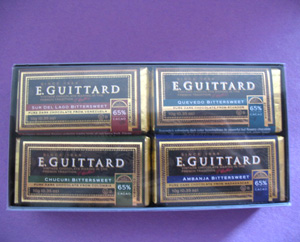
Each Single Origin Tasting Kit, shown above, has four tasting “squares” of each of the four origin chocolates—a total of 16 pieces—plus an introductory brochure. Below, 2-Once Chocolate Bar Sampler.
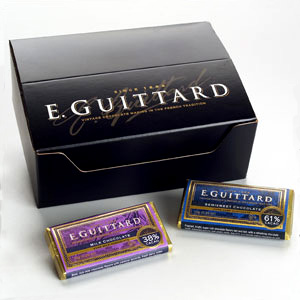
|
Lifestyle Direct, Inc. All rights reserved. Images are the copyright of their respective owners.

|
![]()






 to be precise). When we unwrapped the top layer of the box, which featured one square of each flavor, each had a bas-relief design of native women with a large cacao pod (photo at left). We assumed that every piece was like this, but as we dug deeper into the layers, we discovered the three other designs, variations of the Guittard logo. Now, it would have made sense if each flavor had been given its own design. Then, when the chocolate was unwrapped for a group tasting, the different origins wouldn’t be confused, and everyone could be on the same page (“Now we’re tasting Chucuri, the piece with the large “G” logo in the center.) Instead, like a deck of cards, it seems that each flavor is packed with one of each of the four designs. This means that if four people participate in a tasting, each person’s Chucuri will look completely different from the other.
to be precise). When we unwrapped the top layer of the box, which featured one square of each flavor, each had a bas-relief design of native women with a large cacao pod (photo at left). We assumed that every piece was like this, but as we dug deeper into the layers, we discovered the three other designs, variations of the Guittard logo. Now, it would have made sense if each flavor had been given its own design. Then, when the chocolate was unwrapped for a group tasting, the different origins wouldn’t be confused, and everyone could be on the same page (“Now we’re tasting Chucuri, the piece with the large “G” logo in the center.) Instead, like a deck of cards, it seems that each flavor is packed with one of each of the four designs. This means that if four people participate in a tasting, each person’s Chucuri will look completely different from the other. 




